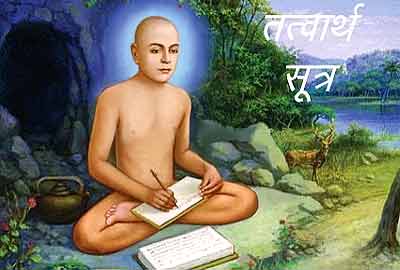 Tattvartha Sutra speaks of epistemological, metaphysical, cosmological, ethical and practical elements in Jainism. It is the first text of Jains in sutra form and brings entire Jain doctrinal system in 350 sutras which are divided into ten chapters. Tattvartha is a Sanskrit word: Tattva means things or realities and artha is true nature. Uma Swami lived around the 2nd century.
Tattvartha Sutra speaks of epistemological, metaphysical, cosmological, ethical and practical elements in Jainism. It is the first text of Jains in sutra form and brings entire Jain doctrinal system in 350 sutras which are divided into ten chapters. Tattvartha is a Sanskrit word: Tattva means things or realities and artha is true nature. Uma Swami lived around the 2nd century.
Tattvartha Sutra is one of the most authoritative books on Jainism. It is the only text authoritative in both Svetambara and Digambara sects of Jainism. It can be compared to the Yoga Sutras by Patanjali in Hinduism. The first verse says that through right faith, right knowledge and right conduct the path of liberation or Moksha can be achieved. The first chapter deals with the process of cognition. The next three deal with the Soul, naraka and celestial abodes. The fifth chapter deals with Ajiva. The next three deal with karmas, good and bad karma, shubha-ashubha karma and the bondage of the karmas, bandha. The ninth deal with the blocking, samvara and shedding of the karmas and nirjara. The last chapter deals with Moksha.
Tattvartha Sutra is also known as Tattvarth-adhigama-sutra and Moksh-Shastra. This text was composed in Patna. This text is recited in Jain temples. It is read generally during festivals. However this text is not a part of the sacred text of Jains. It contains major theoretical and practical aspects of Jain system. It has brought together the scattered material for the first time in a structured manner. It also deals with fundamentals of Jainism. It mentions that without following the three fold path of right faith, right conduct and right knowledge the ultimate cannot be achieved.
The text also describes the methods of obtaining knowledge about the outer world and the inner world. In the first chapter seven elements have been mentioned that are the pre requisites to move onto the path of spiritual progress. The seven elements are living Soul, the non-living elements, the influx of the karmas to the soul, stoppage of karmas and eradication of the existing bondage of the karmas and finally seventh element is the freedom of the soul from the bondage.
Uma Swami systematized the Jain system with a logical sequence by composing this text.
The first verse of first chapter is "Samyag darshan jnana charitrani moksha margah" which means that right knowledge, right faith and right conduct can lead one to Moksha.




















